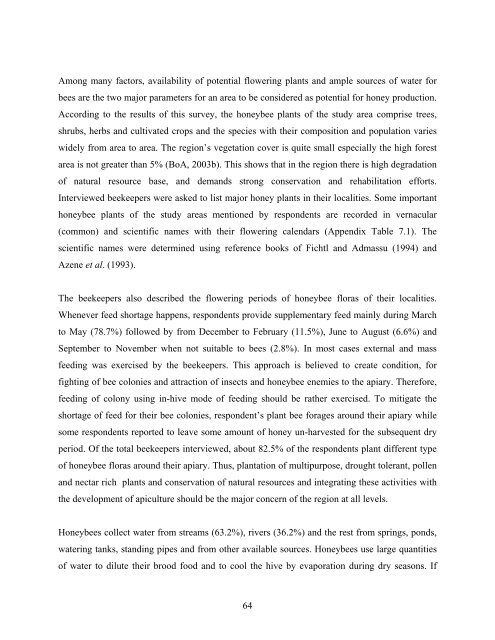Honeybee Production and Marketing Systems, Constraints - IPMS ...
Honeybee Production and Marketing Systems, Constraints - IPMS ...
Honeybee Production and Marketing Systems, Constraints - IPMS ...
- No tags were found...
You also want an ePaper? Increase the reach of your titles
YUMPU automatically turns print PDFs into web optimized ePapers that Google loves.
Among many factors, availability of potential flowering plants <strong>and</strong> ample sources of water forbees are the two major parameters for an area to be considered as potential for honey production.According to the results of this survey, the honeybee plants of the study area comprise trees,shrubs, herbs <strong>and</strong> cultivated crops <strong>and</strong> the species with their composition <strong>and</strong> population varieswidely from area to area. The region’s vegetation cover is quite small especially the high forestarea is not greater than 5% (BoA, 2003b). This shows that in the region there is high degradationof natural resource base, <strong>and</strong> dem<strong>and</strong>s strong conservation <strong>and</strong> rehabilitation efforts.Interviewed beekeepers were asked to list major honey plants in their localities. Some importanthoneybee plants of the study areas mentioned by respondents are recorded in vernacular(common) <strong>and</strong> scientific names with their flowering calendars (Appendix Table 7.1). Thescientific names were determined using reference books of Fichtl <strong>and</strong> Admassu (1994) <strong>and</strong>Azene et al. (1993).The beekeepers also described the flowering periods of honeybee floras of their localities.Whenever feed shortage happens, respondents provide supplementary feed mainly during Marchto May (78.7%) followed by from December to February (11.5%), June to August (6.6%) <strong>and</strong>September to November when not suitable to bees (2.8%). In most cases external <strong>and</strong> massfeeding was exercised by the beekeepers. This approach is believed to create condition, forfighting of bee colonies <strong>and</strong> attraction of insects <strong>and</strong> honeybee enemies to the apiary. Therefore,feeding of colony using in-hive mode of feeding should be rather exercised. To mitigate theshortage of feed for their bee colonies, respondent’s plant bee forages around their apiary whilesome respondents reported to leave some amount of honey un-harvested for the subsequent dryperiod. Of the total beekeepers interviewed, about 82.5% of the respondents plant different typeof honeybee floras around their apiary. Thus, plantation of multipurpose, drought tolerant, pollen<strong>and</strong> nectar rich plants <strong>and</strong> conservation of natural resources <strong>and</strong> integrating these activities withthe development of apiculture should be the major concern of the region at all levels.<strong>Honeybee</strong>s collect water from streams (63.2%), rivers (36.2%) <strong>and</strong> the rest from springs, ponds,watering tanks, st<strong>and</strong>ing pipes <strong>and</strong> from other available sources. <strong>Honeybee</strong>s use large quantitiesof water to dilute their brood food <strong>and</strong> to cool the hive by evaporation during dry seasons. If64
















